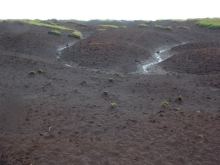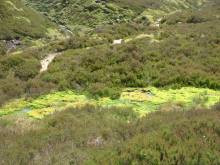Significance

Much of the blanket peat in the UK is eroded or actively eroding. This leads to:
- A loss of amenity.
- Problems with water quality.
- Degradation of a scarce resource which has taken 5,000 years to accumulate.
There are many different stages and types of peat erosion which were introduced in the virtual tour - we suggest you take the tour before you proceed through the rest of the themes pages.
Consequences of erosion

- Reduced species diversity. Cotton grass flourishes whilst other species decline in frequency and abundance.
- Reduced sphagnum cover. Bog Mosses were a common sight in the moorlands up to 250 years ago, but are now rare.
- Plant cover becomes discontinuous - exposure of bare peat becoming more frequent and extensive.
- Vegetation productivity decreases with declining vegetation cover, causing peat production to cease completely.
- Sediment accumulation in reservoirs - effecting water quality.
Causes of blanket peat erosion
There are many causes of peat erosion. Once it is initiated, is often a viscous circle to further erosion of the landscape.
Fresh and fiberous peat is resistant to erosion. Removal of peat from a bare surface typically requires some 'weathering' process to loosen surface particles.
The main weathering processes are frost action and dessication.
The pattern of peat erosion is varied across the British Isles, as well as throughout the Dark Peak, and is therefore thought to be the result of a series of distinct process, initiated at different times and by different causes...
- Peat bogs reach a critical threshold depth in their development at which they become unstable and vulnerable to erosion - i.e. Peat development is a cyclic process of accumulation - erosion - recovering - accumulation.
- Climate change has brought about drier conditions which have caused the peat to dry out and become vulnerable to erosion. This inhibits further peat accumulation and allows deep cracks to form in the peat mass which can initiate gully formation.
Or
Increase in rainfall or increased storm events may also affect peat formation and erosion. - Human influences remove or alter the vegetation cover.
Removal of vegetation means that there are no leaves to intercept rainfall or roots to bind the soil together. This makes it more vulnerable to erosion by water, wind etc.
Humans remove vegetation by:

- Moorland fires. Controlled fires are vital for the management of heather moorland but can become out of control in dry conditions (which may become more common due to climate change).
Over 300 moorland fires were recorded between 1970-1995, burning approximately 42 km2 of moorland (8% of the total Peak District moorland area). - Trampling. Vegetation dies back when crushed by human feet.
- Air Pollution. Studies have shown that Sphagnum moss is very vulnerable to air pollution (sulphuric acid in the atmosphere). Its decline could be attributed to atmospheric pollution originating from the surrounding industrial towns and cities surrounding the Dark Peak.
- Grazing by sheep and grouse. Sheep stocks have been increasing since the 1950s and have been blamed for up to 50km2 of peat erosion.
- Natural processes of gullying and mass movement also erode peat - this is discussed on the next page.
